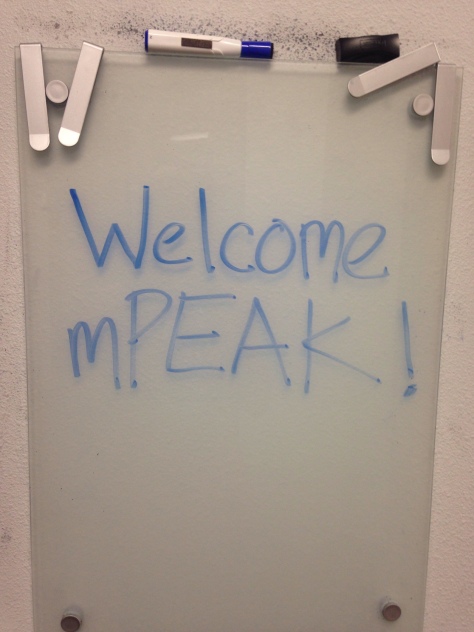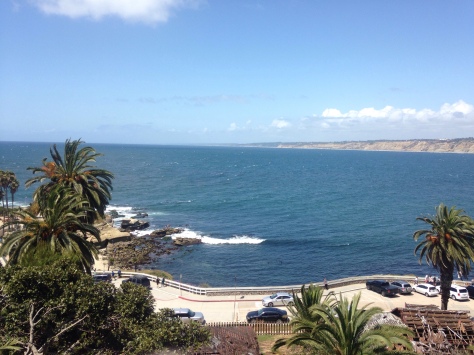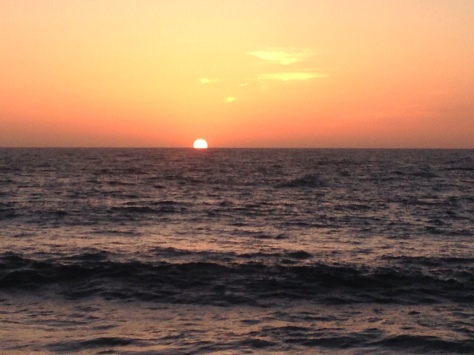I eye the bucket of ice water nervously, the clear cubes of frozen water floating mercilessly near the surface. Feeling my fight or flight system come online, a grim thought arises, I know what this feels like. Yes, I do and it’s intense. I can feel my body preparing.
“You’re going to win this one,” the lady next to me says, encouragingly. “You do this all the time!”
I laugh nervously. I’ve already disclosed to the group that one reason I’ve come to mPEAK was to work on the mental aspect of cold water swim training. Here I am, about to do an exercise that’s just about as similar as you can get while still on dry land.

What is mPEAK?
mPEAK or “Mindfulness for Peak Performance” is a mindfulness training course geared toward folks who want to work toward peak performance in an area or several areas of their lives. The developers of the course have worked with Olympic athletes, therapists, corporate executives, first responders and others. Originally in an eight week format, the version I attended was a three day intensive class with six weeks of follow up sessions offered via teleconference. I decided to attend to improve my skills at the mental aspects of marathon swimming, and also to learn more tools to help athletes I work with as a Psychologist achieve their own peak performance.
The instructors were Pete Kirchmer And Corrie Falcon. Pete was interviewed on the outside online podcast (which you can listen to here). I listened to the interview and was so impressed with Pete’s presentation of such a complex topic that I decided to attend.
During the introductions, I was surprised and thrilled to learn that Corrie Falcon, the co-instructor, was a competitive swimmer the same time I was. She swam for University of Southern California and made the U.S. National Team, an accomplishment that is on par with becoming an Olympian. She coached the University of California San Diego swim team for a number of years and now works with UCSD athletes and coaches across all sports on the mental aspect of their performance. I can’t imagine a person better equipped to help me learn these skills as an athlete or supporter of other athletes.
It was in the competent hands of these instructors that I placed my willingness to keep an open mind and try some challenging things.
At Corrie’s prompt, I plunge my hand into the cold water bucket. A surprising moment of relief and pleasure at the cold arises, and then the familiar discomfort, pain, the urge to change my circumstance, to remove my hand or think about something else. I remember that this is an experiment. I’m supposed to actively distract myself from the hand in the water, to exert my mental energy avoiding the sensation, to try not feeling what I’m actually feeling. I start singing a song in my head. It’s one of the ones I like having in my head when I swim hard. I mouth the words into the air of the conference room. I look out the window, look at Corrie and Pete, at the floor, the door, the ceiling, the table behind me. As I do this, my mind is drawn back to the cold hand, now starting to go numb. I get an urge to do a dexterity test, to reassure myself nothing bad is happening. I’m supposed to distract myself, I remember, looking around the room again. Everyone looks calm, some participants are thoughtfully removing their hands from their buckets. Others sit stoically, or look around the room like me. I guess let’s see what happens, I remark to myself. I think about people I know who are not there, about my dog, my house, Dan, people I work with. Again and again my mind goes back to check in on my hand. Without intending to, I compassionately and grimly remind myself that all is well and that I can do this. Eventually, Corrie says to stop. I’m not even feeling like I have to remove my hand, but I do it anyway.
Then we do another round, with the other hand. This time, we are instructed to try the opposite, focusing instead on the sensations, observing them carefully and redirecting the mind back to the hand if it falls into distraction.
So again I plunge the other hand in and open my mind to how it quickly starts to hurt. What the f*ck is this sh*t?! I wonder, hopefully in my head and not aloud. I force myself to stare at my hand, to get absorbed into the pain, to not direct my attention away. All I want to do is take it out. It’s uncomfortable. Everything sucks. I say compassionate things to myself, this hurts, but you can do it. I start to wonder if this hand has more nerves in it. Frustration ensues. More swear words. The realization that this way is much, much harder comes up, then the disappointment that it didn’t work as I expected. The thought, “what is wrong with me?” plays over and over. All the while there is the pain, front and center in my mind, filling almost all my awareness, leaving no room for anything else aside from the negative thoughts and feelings squeezing themselves into every nook and cranny of available mental space.
After Corrie said to remove our hands from the buckets, we raised our hands to indicate which was easier, the second or first round. I was surprised and relieved to find that the vote was split about 50/50. Pete said that this split was actually pretty typical for the trainings he had led. Relief flooded me. I wasn’t the only one. My story that there was something wrong with me turned out to be false. It was my preconceived expectation that was incorrect or unrealistic. Pete went on to say that studies have found people report the exercise to be less painful and are able to persevere longer after having completed an eight week mindfulness course. After my experience, I can see why.
Trying Too Hard
While I was trying to be mindful on the second trial, I was overcome by negative feelings and stories about my perceived inadequacies. I was trying very hard to “be present” with my sensations and indeed, I became hyperabsorbed by the pain, so much so that I lost track of everything else that was happening in my experience and automatic thoughts were left free to run rampant and unchecked, quickly giving rise to negative core beliefs. I got totally wrapped up in my negative story and wasn’t really present after all. When I was trying to be distracted, I actually was more balanced. Despite my efforts not too, I checked in regularly with my painful sensations–yep, still there, yes still uncomfortable, that’s ok you can do it.
Pete introduced a metaphor of putting a handful of salt in a glass (which tastes terrible) versus putting the same sized handful of salt into a lake, (where the water still tastes fine). To make the pain less, we would have to “make a bigger lake”. I realized that I had accidentally done this on the first trial while attempting to distract myself. My awareness had become bigger. The pain was still there, but I had intentionally and compassionately filled my awareness with other things that I enjoy thinking of. My “lake” included my psych-up song, my friends, my current surroundings, the breath, my other hand and of course, the pain. I was still aware of the pain, and I allowed it to be there but there were so many other things there with it. In the second trial, the salt (or pain) filled the whole glass (my mind). I didn’t expand around it, I tightened down and made my mind smaller so I would think of nothing else. To make matters worse, the physical pain triggered an emotionally painful story, which became my sole focus.
One of my many takeaways from mPEAK is that if you try too hard to force helpful mind states like “flow”, being in the zone, or mindfulness, you might get something opposite. I think this is well illustrated to me in the experience with the ice bucket challenge.
The Cost of Distraction
During the discussion of the ice bucket challenge, the issue of the cost of distraction came up. When I shared my experience with the group, Pete skillfully pointed out that in fact, I wasn’t able to completely distract myself. I couldn’t really avoid my physical pain. So, first of all, it may not be possible or sustainable to rely on distraction as a method of coping. In the absence of skills like acknowledging and self-compassion, which I accidentally used, distraction would not have been sufficient. Eventually, I would’ve had to take my hand out if the water. If this were a race or channel crossing, I’d have to get out. Another issue that was raised was that tuning in to physical sensations provides important information. Pete gave examples of athletes who ignored or distracted from physical pain, only to find they had ignored an injury too long, resulting in further injury and much longer recovery than if they had tuned into the pain, listened to it and taken a break sooner.
As swimmers who constantly need to monitor our shoulders for signs of injury versus signs of the normal aching that comes with effective training, this example hits home.
I regrettably did not take a photo of the ice bucket challenge, but here is a picture of the cave I wisely avoided venturing to on my own for the first time. “People swim through it often, when conditions are right,” local open water leader, Dan Simonelli told me. But as a beginner to the area, swimming on my own, I decided to listen to my fear of being slammed into rocks by waves rather than distract from that particular fear in order to swim on toward the cliffs. The water looks calm here, but it wasn’t the day before.

Another application is for cold water training. For instance, my intuition during both ice bucket trials was to check my dexterity to make sure I could still move my fingers. I’ve practiced doing this a lot in my cold swims. Dexterity is one of the tests me and Dan do together when he kayaks along with me. He asks me to show him I can still touch my thumb to each finger. If I can’t, that isn’t a sign to panic, but it’s really important information that he and I will use to determine if it’s time to get out or not. If we both avoid thinking about how my body feels and is reacting to the cold, we won’t know when to get out. Hypothermia can be dangerous. It’s important to push yourself, but it’s important to know when to stop. In my blog post about beginners mind in cold water, I wrote about this need to tune in to the senses when training in the cold and I had that very much validated during mPEAK.

A Mindful Swim
That evening, I went for a solo swim at La Jolla Cove to test one further application: coping with fear. The sun was heading toward the horizon and the water was more clear than it had been on my previous two swims the days before. Bright-orange garibaldi fish swam lazily below me as I headed out into the water. I noticed I felt more edgy about the extremely low possibility of encounter with potentially dangerous (ahem) “wildlife”. Sunset, sunrise… these are feeding times for many animals, many types of, well wildlife, I thought nervously as I swam along, passing the last swim buoy and heading into the territory beyond the now familiar swim buoy course. I decided to try out what I had learned at mPEAK. I acknowledged the fear, but didn’t dwell on it. I generated some positive thoughts and stayed present with other aspects of the current experience–the sky above, the clouds around the sun, the gentle waves lifting me up and down, and the long stretch of my stroke in the water. I tried to stay present with the uncertainty and the fear sensations but also not become overwhelmed by them. What is actually happening right now?, I asked myself, many times. I am swimming. I can feel the water and see it’s color. I am breathing. I am pulling. I am gently kicking. There is a nervous energy in my body. I am having thoughts about danger. And you know what? The fear just came and went the whole time. I just observed it. It was not as noticeable as I swam back toward the buoys and past them toward shore, but stronger again as I headed away from shore on another loop around the buoys. When I started swimming the final stretch back to shore, it was from a place of self-compassion rather than panic or fear. I felt done practicing swimming and done practicing being present with difficult sensations. I was ready for dinner and the comfort of my warm bed.

Drafting with the Peloton: the Value of Group Mindfulness Practice
“I have a hard time with group meditation,” I told my Psychologist colleagues, before coming the mPEAK. Prior to this experience, I’ve always been overwhelmed by my perception of other’s expectations of me while meditating in group settings. I should be doing this posture or have a certain facial expression if I am serious about meditation. I should practice this many times a week for this many minutes. I should only think about the breath. Lying down is inferior to sitting in the classic meditation stance. These are the sort of thoughts I imagine my fellow meditators to have in other group settings I have tried. At mPEAK, the message was clear and very different, both from the leaders and from other participants. Pete stressed what he called, “radical self-care”, which included encouragement to lie down, stand up, take a bathroom break, drink water or anything else we truly felt we needed. He recommended we consider things before doing them, but then decide to do what we think would be best, while maintaining a sense of mindful awareness. The implication was that we are wise enough to truly consider what will be the best posture, action or inaction for our own paths. For me, this often meant taking a more casual-looking stance or facial expression than you might see in the movies. I doubt anyone noticed, but permission to do this, to not fit the preconceived notion made all the difference to me.
I found many similarities between my fellow participants and people I connected with at SCAR. Both groups of people struck me as kind, resilient, community-minded and tough as nails. As a group, we defined our values from the beginning. Many group members had values congruent with mine, including compassion, striving for non-judgement and holding things lightly. As I got to know my fellow group members, I found it easier and easier to just be myself. This group environment and support allowed me to discover things I didn’t know about myself and wouldn’t have figured out without their influence.
For instance, during a yoga practice, we were invited to adopt the expression of a warrior. I felt brief social pressure to arrange my facial features in a certain way, channeling what I imagined other people thought of as a warrior. I caught myself doing this and realized that this group really wasn’t like that and I truly was free to do my own thing. It prompted me to really think about it. Then I realized that for me, a warrior’s mindset is kind of matter-of-fact, stoic and includes a bit of dry humor–like Woodrow McCrae in Lonesome Dove. Well, my arms might fall off while I’m doing this yoga pose, but best thing to do is just sit here and see what transpires, I thought, channeling my favorite Larry McMurtry characters. This is the thought of an individual and maybe I could’ve had it alone. But! The experience of feeling supported in having an individual thought and behavior that differed slightly from the group, while still in a group is something I simply couldn’t get without the acceptance and openness that I sensed from this particular group.
Using the examples of cyclists riding in a big group (or “peloton”) to draft off one another and make for a swifter journey, Pete explained that he believes there is a draft for mindfulness as well. We are stronger together, actually. Despite my previous fear, I’d have to agree. I think we are stronger together, especially when people are willing to be themselves with courage, even when we have different ways of doing things. When we are doing the work together, we are a stronger force against the winds that attempt to push us backwards. I know I certainly wouldn’t have made the progress I did without the help of the group this weekend. During the mindful practices, I felt comforted, calmed and encouraged by the people around me. When others shared their stories, I learned so much, was inspired and felt connected in a way that gave me the courage to keep showing up fully. What implications could this have for helping athletes working together in teams? Are there ways that teammates and communities of athletes can support each other’s mental toughness development? Can we achieve more together than we could dream of as individuals? I absolutely think so.
